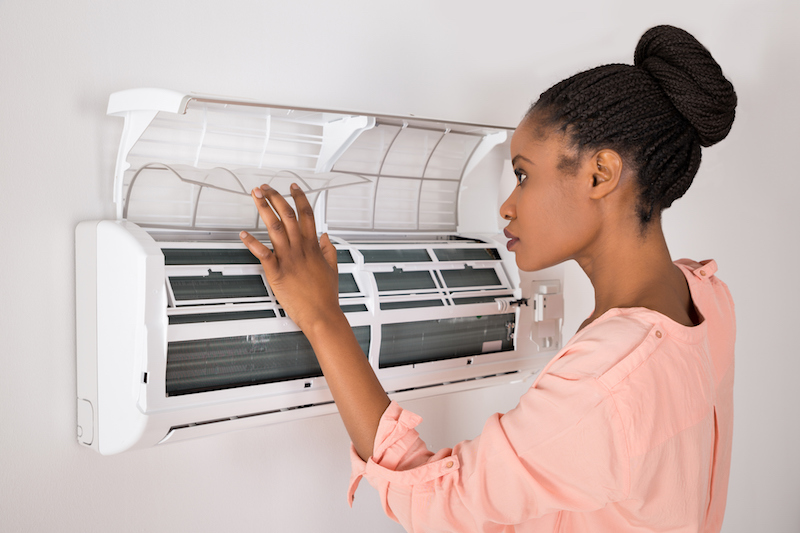
You shouldn’t need to compromise on comfort or spend a lot to keep your home at a refreshing setting during warm days.
But what is the right temperature, exactly? We review ideas from energy pros so you can choose the best temp for your residence.
Here’s what we advise for the most energy-efficient setting for air conditioning in Menomonie and western Wisconsin.
Recommended Thermostat Settings for Summer
Most families find using the thermostat at 72-73 degrees is most comfortable. However, if there’s a sizeable difference between your interior and exterior temperatures, your cooling bills will be greater.
This is our advice based on the U.S. Department of Energy (DOE) and ENERGY STAR®.
While at home: 78 degrees. While that appears too high, there are ways you can keep your house cool without having the air conditioning going frequently.
Keeping windows and window treatments shut during the day keeps cold air where it needs to be—inside. Some window solutions, including honeycomb shades or plantation shutters, are made to provide added insulation and improved energy savings.
If you have ceiling fans in your house, the DOE says you can raise thermostat temps about 4 degrees warmer without compromising comfort. That’s because they cool by a windchill effect. As they cool people, not spaces, switch them off when you leave a room.
If 78 degrees still seems too hot initially, try running an experiment for about a week. Get started by raising your temperature to 78 degrees while you’re at your residence. Then, progressively turn it down while using the tips above. You could be amazed at how cool you feel at a warmer temperature setting.
While away: 88 degrees. There’s no reason to keep the AC working all day while your home is unoccupied. Turning the setting 7–10 degrees warmer can save you as much as 5–15% on your air conditioning expenses, according to the DOE.
When you arrive home, don’t be tempted to put your thermostat colder than 78 to cool your residence more quickly. This isn’t effective and usually results in a higher electrical bill.
A programmable thermostat is a useful approach to keep your temperature controlled, but you have to set programs. If you don’t use programs, you might forget to change the set temperature when you take off.
If you want a handy resolution, think about getting a smart thermostat. This thermostat connects with your phone, so it knows when you’re at your house and when you’re away. Then it intuitively adjusts temperature settings for the biggest savings. How much exactly? Usually $180 yearly on heating and cooling, according to ENERGY STAR.
Another perk of using a smart thermostat? You can use your phone to monitor and adjust temperature settings from nearly anywhere.
While sleeping: Around 70 degrees. While ENERGY STAR recommends 82 degrees, that might be too uncomfortable for many families. Many people sleep better when their bedroom is cold, so that’s why the National Sleep Foundation recommends 60–67 degrees. But that may be too cool, depending on your clothing and blanket preference.
We suggest using a similar test over a week, moving your thermostat higher and steadily turning it down to determine the ideal temp for your residence. On mild nights, you may learn keeping windows open at night and using a ceiling fan is a superior solution than running the air conditioning.
More Approaches to Use Less Energy During Hot Weather
There are additional methods you can conserve money on AC bills throughout hot weather.
- Buy an energy-efficient cooling system. Central air conditioners only are effective for about 12–15 years and lose efficiency as they get older. An updated air conditioner can keep your home cooler while keeping electricity bills down.
- Set annual air conditioner service. Routine air conditioner maintenance keeps your system operating like it should and might help it work at better efficiency. It can also help lengthen its life cycle, since it helps pros to find small troubles before they cause a major meltdown.
- Replace air filters frequently. Read manufacturer instructions for changing your air filter. A dirty filter can lead to your system short cycling, or run too much, and drive up your utility.
- Measure attic insulation levels. Almost 90% of residences in the United States don’t have proper insulation, according to the Insulation Institute. The majority of southern climates should have 13–14” of attic insulation, while northern climates should have 16–18”.
- Have your ductwork checked. Ductwork that has separated over time can leak conditioned air into your attic, walls or crawl space. This can lead to huge comfort issues in your house, like hot and cold spots.
- Seal cracks, doors and windows. Keep muggy air where it belongs by sealing holes. You can also caulk or weather strip doors to trap more cold air within your home.
Use Less Energy During Warm Weather with Halverson Brothers Inc
If you want to use less energy during warm weather, our Halverson Brothers Inc pros can provide assistance. Give us a call at 715-352-4052 or contact us online for extra information about our energy-saving cooling solutions.






